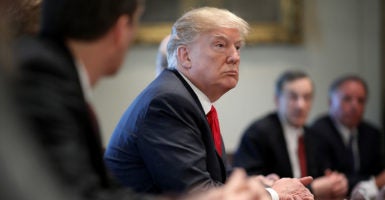President Donald Trump announced last week he will add an additional 5% tariff on all Chinese products bought by Americans.
This comes on top of an existing 25% tariff on $250 billion worth of products from China, and an additional tax on roughly $160 billion worth of goods is set to start Sept. 1.
Given that U.S.-China negotiations are unlikely to be resolved anytime soon, Americans should expect to pay another tax on roughly $140 billion worth of goods starting Dec. 15. By the end of the year, everything Americans buy from companies in China worth roughly $500 billion in annual imports will cost an additional 15% to 25%, or more.
By now, the recent escalation of tariffs should come as little surprise to anyone. The administration has continued to increase taxes on Chinese imports over the last year without hesitation.
The president has become so reliant on tariffs as a negotiating tool that there’s little room left to discuss other more effective policies to deal with China’s misbehaviors—policies that don’t involve taxing American consumers.
Yet as the U.S. becomes more desperate for a deal with China, the president’s tough negotiating style is only likely to harden.
In fact, Trump still has room to increase the tariff rate on $300 billion worth of Chinese imports from 15% to 25%. To think—a president can levy a 10% tax with as much ease as sending a tweet while Congress sits idle.
He could increase the tariff rate even further, but that would require more time through regulatory procedures.
Trump’s recent decision to further increase taxes wasn’t entirely random. It came after Chinese officials announced Friday morning their plans to levy their own tariffs on U.S. imports.
For the last year, Chinese officials have consistently responded to U.S. tariffs with their own tariffs. It’s why China has its own tariffs on $110 billion worth of U.S. imports, and it’s why U.S. farmers have lost significant market share in China.
This most recent announcement by Chinese officials seemed to upset Trump the most.
Perhaps it was timing. China’s announcement was delayed since Chinese leaders were away for most of August. Or perhaps it was because Trump was on his way to the G-7 meeting in France to talk about trade and he wanted to set an example.
Regardless of his reasoning, on Friday, the president’s decision to boost tariffs sent markets into a frenzy.
In addition to the new tariffs, Trump suggested he could go even further by ordering U.S. businesses to find an alternative to China.
As of 2018, U.S. companies have directly invested $117 billion in China. Meanwhile, U.S. companies reliant on trade with China would start to close, given the immediate shock to their supply chains.
It would also have a major negative impact on the global economy. It’s not for nothing that economists are warning the U.S.-China trade war has the potential to tip much of the global economy into a recession.
Given the size of China’s market, even if American companies could be directed out of China, plenty of America’s economic partners would easily assume the abandoned American share.
To think, this whole trade war with China started because the U.S. Trade Representative’s Office determined Chinese policies and practices, including cyber theft, are a cost (not a loss) of $50 billion a year for the U.S. economy.
When the president references the billions China is taking out of the U.S., as he did at the G-7 meeting, he’s actually talking about the trade deficit. This is in no sense a “loss” or “theft”; it’s commercial exchange. It’s no more China stealing from us than the grocery store steals from you when you buy bread.
It’s bad enough the administration continues to increase taxes on Americans, but to suggest the president can command U.S. businesses where they can and cannot invest is against the principles of a free market economy.
This administration can do better.






























